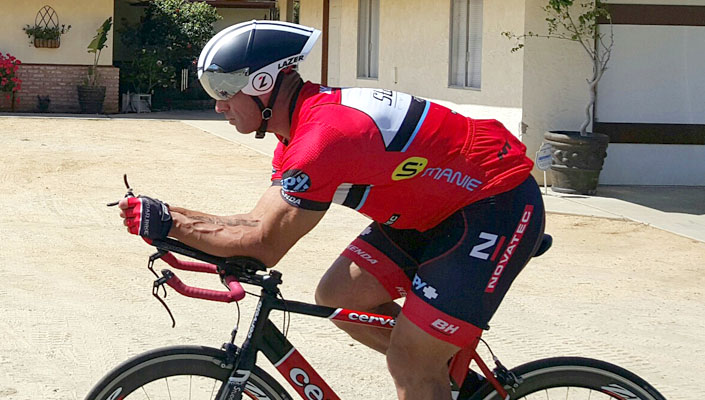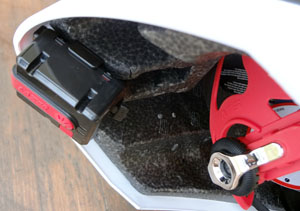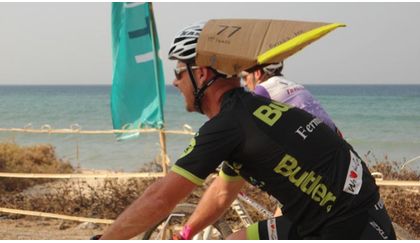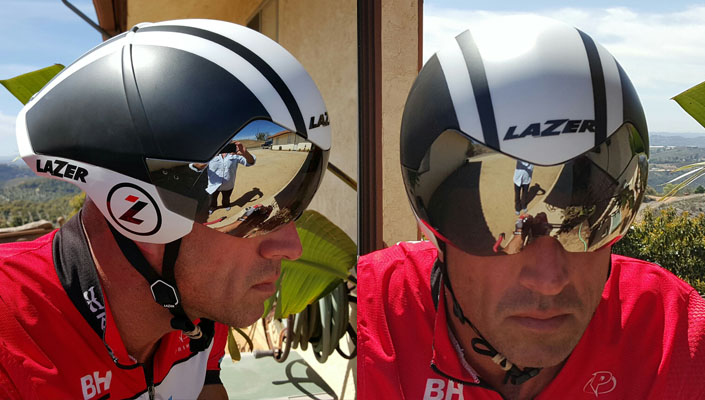

image: Anthony Morrow | BikeRoar
What’s the biggest problem with aero helmets? For me, at least, it’s always been the case that while traditional time trial helmets work fine in shorter races (where my aero tuck positioning was as close to perfect as I was ever going to get it), they were ruthless in penalizing me as my form and posture deteriorated in longer events. Compared to a full time trial, or triathlon helmet, the Lazer Wasp Air has a much shorter tail. The theory here is that while this does not provide maximum aerodynamic gains in a perfect position, it provides much greater aerodynamic performance when sitting up and when the rider’s aero position is less than perfect. This makes sense when you think about it – with a regular TT helmet, the moment you start to lose form and drop your head, the long tail of the helmet is waving in the air like a flag or a sail, catching air and slowing you down... the shorter, stubbier tail of the Wasp Air has far less surface area to slow down an already-exhausted rider.
Most time trial helmets, especially those with visors, are notoriously difficult to get on. However, with Lazer's ATS (Advanced Turnfit System), the Wasp Air helmet was easy to slip on, fit, and adjust while wearing; the trick is to dial open the retention system, slip the helmet on, and then tighten it up. It sat low and comfortable while cradling the back of my skull. Weighing in at just 375 grams (13.75 ounces) for a small/medium size, it’s on the light side, which is a definite plus during a longer time trial.
The helmet’s integrated visor gives a nice full field of vision. A handy feature to the ventless aero helmet is that the visor can be moved forward to allow airflow through the helmet, passing over a rider’s head and out the two tail vents. While this helps extend comfort as temperatures get warmer, it's still not enough on significantly hot days and long rides (and is almost certainly why Lazer has introduced the Wasp Air Tri model with front air inlet and Aquavent). I was challenged to adjust the visor to limit under airflow that caused my eyes to water at high speeds (30+ MPH). The visor is easy to change: it simply snaps into the sides of the helmet, but care is required as the tabs are attached by tiny set/grubs screws.

image: Anthony Morrow | BikeRoar
The second part of the fitting process was to get the Inclination Sensor (the "IS" in the helmet's name) charged and calibrated. The small 2" unit - included with this helmet model, but also sold as a separate accessory - gives auditory and/or vibration feedback when the rider's head moves out of optimal position. It easily snapped into the back of the helmet (as it would on similarly compatible Wasp Air Tri and Tardiz models). Charging power and configuration connectivity to the unit are via a provided USB cable. Lazer lists the battery life (Li-ion) between six and eight hours when the device is continuously giving feedback.
I download and installed the IS software. Once the software installed and unit charged, the calibration process required me next to fit the unit into the helmet and then ride on an indoor trainer for several minutes to get into an optimal aero position. An assistant, my wife, was needed to press and hold the calibration button for 3 seconds to save the setting. The instructions call for “an assistant”, but the reality is you’ll want somebody who knows their stuff and preferably a qualified and experienced bike fitter to help with your position and set-up process. It's not that the sensor isn't easy to understand and set, but if you get this step wrong, the whole point of benefits from optimal helmet position and feedback get lost. So, take your time here and make sure you get it right.
Connected back to the computer, I selected settings from auditive (beep) and/or tactile (vibration) for the type of feedback desired. I like the option to choose either or both, but the vibration was hard to notice when riding at speed. I eventually went with the audible setting as it can be reliably heard at any speed.
Setting selection also includes the degree of angle at which the rider wants feedback to begin, ranging from 0-45°. There's no recommendation provided on degree of deviation from the calibrated "optimum" head angle, so I went with trial and error. My initial setting of 10° was far too narrow. Setting to 20° was a reasonable range. This is clearly a matter of personal preference and experience and is worth experimenting with at length before racing with the helmet. Once you find your sweet spot, calibration settings can be stored on computer and uploaded to the device, allowing you to use multiple calibrations, perhaps for different bike setups, or to share the sensor with another rider.

Do know that Lazer says the Inclination Sensor is not to be used "during rain or snow fall." I'm not one to TT in snow, but not being usable in the rain is an unexpected limitation. The unit appears sealed and up to the task, but I didn't press the issue and called off one rainy day test.
RELATED: Aero road bike or TT bike?
Summary:
The Lazer Wasp Air is one of the most comfortable fit and feel aero helmets I’ve ever worn and I definitely recommend it. While the Inclinations Sensor set-up is lengthy and somewhat haphazard, it's an investment one must be willing to make, along with training to get comfortable using it, to eek out aero gains in the long run. Whether you choose the Lazer Wasp Air with our without the Inclination Sensor, it's a great helmet and justifies the price tag.

SRP: $120.00 USD
€139.95 EU / £ 149.99 UK
229.95 AUD

RELATED ARTICLE:
Aero helmets - What do I need to know?
Aero - a word bandied about as the springboard to all of your cycling-related aspirations. An abbreviation for aerodynamic, in cycling aero encompasses your riding position, bike, and any modifications to specific components in order to reduce the... READ MORE

RELATED ARTICLE:
How to clean and inspect your bike helmet
If you are looking for a new challenge, the Haute Route may be itBikeRoar first hand look at what it takes to ride the... READ MORE






